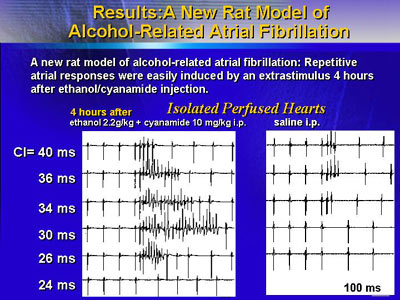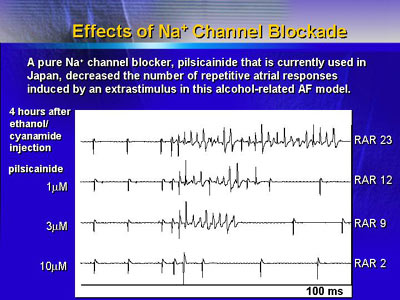|
In a rat model of induced atrial fibrillation,
alcohol caused short-term ion channel remodeling that produced
arrhythmogenic substrates within a few hours. Sodium channel
blockade with pilsicainide was effective in suppressing the
alcohol-induced atrial fibrillation.
Studies have shown that alcohol consumption is an independent
risk factor for paroxysmal atrial fibrillation. The mechanisms
of this association are not clear, although alcohol intake
could cause short-term biochemical reconstruction of ion channels
(electrical remodeling).
To examine the underlying mechanisms of alcohol-induced
atrial fibrillation, Dr. Yamashita and colleagues created
a new rat model and used the rats to assess the anti-arrhythmic
effects of the pure sodium channel blocker pilsicainide.
Investigators injected the rats intraperitoneally with ethanol
(up to 4.4 g/kg) plus cyanamide (0-200 mg/kg). Then, they
assayed gene expression of a series of K+ and HCN
cardiac ion channels. They correlated results of the assays
with electrophysiologic studies in isolated perfused hearts.
A single stimulus significantly increased the number of
repetitive atrial responses from 4.8 to 23.2. Atrial refractory
period shortened from 32 to 23 ms, and sinus cycle length
decreased from 259 to 207 ms.

Introducing the pure sodium channel blocker pilsicainide
effectively decreased the number of stimulus-induced repetitive
atrial responses in a dose-dependent manner. The drug decreased
the number of repetitive atrial responses despite no apparent
change in wavelength index. Pilsicainide also prolonged intra-atrial
conduction time and effective refractory period in a dose-dependent
manner.

Although pilsicainide decreased repetitive atrial responses
in most rats, the sodium channel blocker induced tachycardia
that did not self-terminate in 2 out of 15 rats.
Dr. Yamashita and colleagues have successfully created a
new rat model of alcohol-induced atrial fibrillation that
includes upregulation of cardiac ion channels Kv1.5 and HCN4.
The pure channel blocker, pilsicainide, induced a satisfactory
suppression of arrhythmia in this model. This validates the
current therapy for alcohol-induced paroxysmal arrhythmia
and provides insight into the mechanisms behind this condition.
|